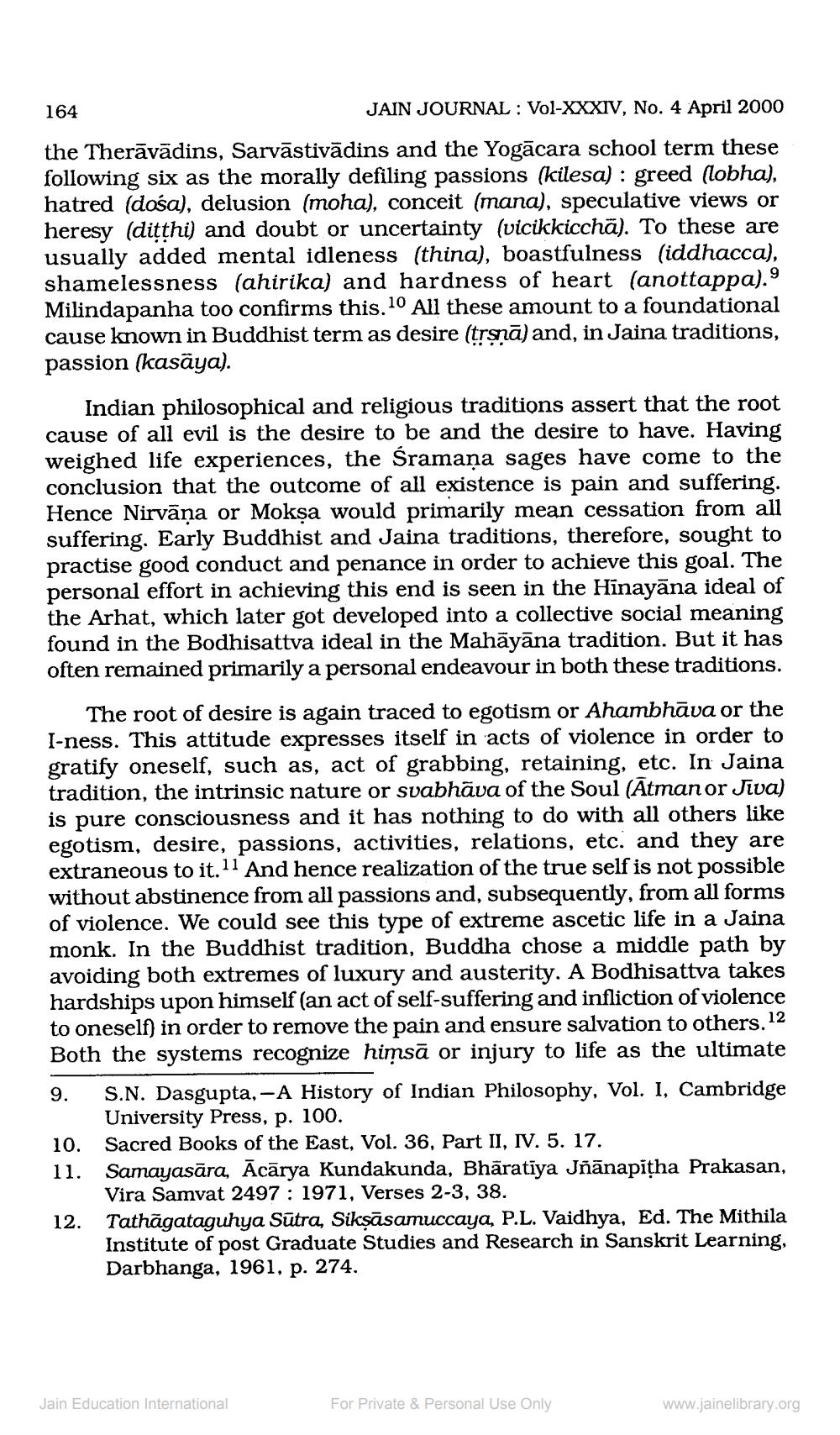Book Title: Jain Journal 2000 04 Author(s): Jain Bhawan Publication Publisher: Jain Bhawan Publication View full book textPage 8
________________ 164 JAIN JOURNAL : Vol-XXXIV, No. 4 April 2000 the Therāvādins, Sarvāstivādins and the Yogācara school term these following six as the morally defiling passions (kilesa) : greed (lobha), hatred (dosa), delusion (moha), conceit (mana), speculative views or heresy (diţthi) and doubt or uncertainty (vicikkiccha). To these are usually added mental idleness (thina), boastfulness (iddhacca), shamelessness (ahirika) and hardness of heart (anottappa).9 Milindapanha too confirms this. 10 All these amount to a foundational cause known in Buddhist term as desire (trsnā) and, in Jaina traditions, passion (kasāya). Indian philosophical and religious traditions assert that the root cause of all evil is the desire to be and the desire to have. Having weighed life experiences, the Sramaņa sages have come to the conclusion that the outcome of all existence is pain and suffering. Hence Nirvāṇa or Moksa would primarily mean cessation from all suffering. Early Buddhist and Jaina traditions, therefore, sought to practise good conduct and penance in order to achieve this goal. The personal effort in achieving this end is seen in the Hinayāna ideal of the Arhat, which later got developed into a collective social meaning found in the Bodhisattva ideal in the Mahāyāna tradition. But it has often remained primarily a personal endeavour in both these traditions. The root of desire is again traced to egotism or Ahambhāva or the I-ness. This attitude expresses itself in acts of violence in order to self, such as, act of grabbing, retaining, etc. In Jaina tradition, the intrinsic nature or svabhāva of the Soul (Ātman or Jiva) is pure consciousness and it has nothing to do with all others like egotism, desire, passions, activities, relations, etc. and they are extraneous to it. 11 And hence realization of the true self is not possible without abstinence from all passions and, subsequently, from all forms of violence. We could see this type of extreme ascetic life in a Jaina monk. In the Buddhist tradition, Buddha chose a middle path by avoiding both extremes of luxury and austerity. A Bodhisattva takes hardships upon himself (an act of self-suffering and infliction of violence to oneself) in order to remove the pain and ensure salvation to others. 12 Both the systems recognize himsā or injury to life as the ultimate 9. S.N. Dasgupta, - A History of Indian Philosophy, Vol. I, Cambridge University Press, p. 100. 10. Sacred Books of the East, Vol. 36, Part II, IV. 5. 17. 1. Samayasāra, Ācārya Kundakunda, Bharatiya Jñānapitha Prakasan, Vira Samvat 2497 : 1971, Verses 2-3, 38. 12. Tathāgataguhya Sūtra, Sikşāsamuccaya, P.L. Vaidhya, Ed. The Mithila Institute of post Graduate Studies and Research in Sanskrit Learning, Darbhanga, 1961, p. 274. Jain Education International For Private & Personal Use Only www.jainelibrary.orgPage Navigation
1 ... 6 7 8 9 10 11 12 13 14 15 16 17 18 19 20 21 22 23 24 25 26 27 28 29 30 31 32 33 34 35 36 37 38 39 40 41 42 43 44 45 46 47
